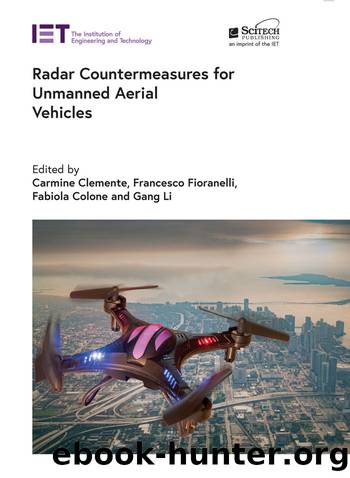Radar Countermeasures for Unmanned Aerial Vehicles by Clemente Carmine;Fioranelli Francesco;Colone Fabiola;Li Gang;

Author:Clemente, Carmine;Fioranelli, Francesco;Colone, Fabiola;Li, Gang;
Language: eng
Format: epub
Publisher: Institution of Engineering & Technology
Published: 2021-08-20T16:00:00+00:00
6.5.2 Exploitation of the frequency and spatial diversity to improve the detection and localization performance
As it is well known, target detection performance depends highly on the selected transmitter of opportunity and, in particular, it significantly varies with the employed DVB-T channel. The radiating characteristics of the transmitter and the electromagnetic conditions of the propagation channel vary across the wide frequency band allocated to the DVB-T service in the UHF band (from 470 to 862 MHz). In addition, also the target scattering can change with the different considered frequency channels. Eventually, target DoA estimation is characterized by low accuracies when operating at UHF band. Moreover, as mentioned in the previous section, when we operate with a uniform linear array, the requirements of accurate DoA estimation and wide unambiguous angular sector sets competing constraints on the array equivalent length.
To overcome the aforementioned limitations, we can take advantage of the frequency and spatial diversity allowed by the multi-frequency operation and a NULA layout. Specifically, aiming at improving the target detection capability and the reliability of the considered system, we consider the joint exploitation of multiple DVB-T channels emitted by the same broadcast illuminator of opportunity based on the detection schemes proposed in [12]. Among the different MF operation approaches, the decentralized detection scheme (MF DEC) is adopted in the following since it has been shown to be more robust to the presence of ghost targets or unwanted plots formations. Therefore, a detection is declared at a given range/velocity location when L detections out of Q available frequency channels are obtained for the considered rangeâDoppler bin [l0, m0] of the maps separately evaluated at each surveillance channel. Specifically, by defining bq[l0, m0] the binary map at the output of the CFAR detection stage of Figure 6.6, we obtain
Download
This site does not store any files on its server. We only index and link to content provided by other sites. Please contact the content providers to delete copyright contents if any and email us, we'll remove relevant links or contents immediately.
| Automotive | Engineering |
| Transportation |
Whiskies Galore by Ian Buxton(41524)
Introduction to Aircraft Design (Cambridge Aerospace Series) by John P. Fielding(32881)
Small Unmanned Fixed-wing Aircraft Design by Andrew J. Keane Andras Sobester James P. Scanlan & András Sóbester & James P. Scanlan(32567)
Craft Beer for the Homebrewer by Michael Agnew(17926)
Turbulence by E. J. Noyes(7690)
The Complete Stick Figure Physics Tutorials by Allen Sarah(7134)
Kaplan MCAT General Chemistry Review by Kaplan(6584)
The Thirst by Nesbo Jo(6432)
Bad Blood by John Carreyrou(6270)
Modelling of Convective Heat and Mass Transfer in Rotating Flows by Igor V. Shevchuk(6218)
Learning SQL by Alan Beaulieu(6023)
Weapons of Math Destruction by Cathy O'Neil(5819)
Man-made Catastrophes and Risk Information Concealment by Dmitry Chernov & Didier Sornette(5638)
Digital Minimalism by Cal Newport;(5383)
Life 3.0: Being Human in the Age of Artificial Intelligence by Tegmark Max(5181)
iGen by Jean M. Twenge(5149)
Secrets of Antigravity Propulsion: Tesla, UFOs, and Classified Aerospace Technology by Ph.D. Paul A. Laviolette(4973)
Design of Trajectory Optimization Approach for Space Maneuver Vehicle Skip Entry Problems by Runqi Chai & Al Savvaris & Antonios Tsourdos & Senchun Chai(4837)
Electronic Devices & Circuits by Jacob Millman & Christos C. Halkias(4739)
